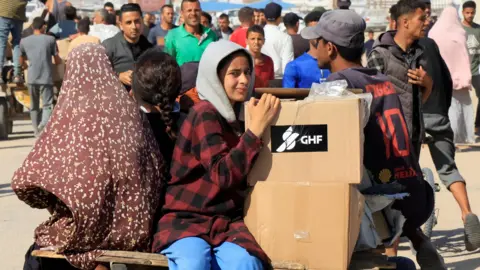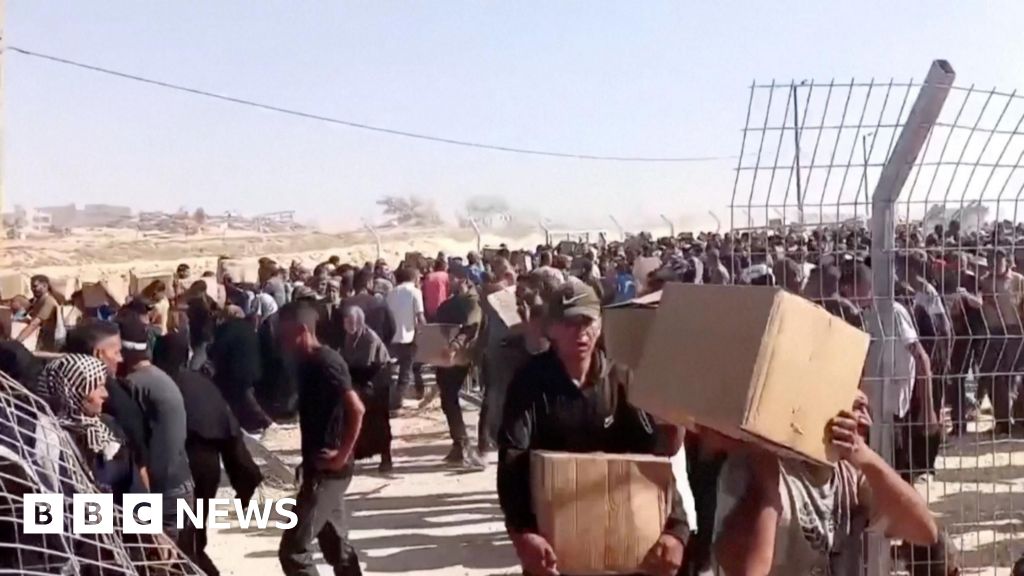The crowds break into the new US -backed aid distribution center
Thousands of Palestinians exceeded the aid distribution site in Gaza, which was established by a controversial group and supported by an Israeli, a day after the start of work there.
Videos showed the crowds that walk on the fences that tear it and the ponds of the land in the Gaza Humanitarian Foundation complex (GHF) in the southern city of Rafah.
The group said that at some point its team retreated because the numbers seeking help were very large. The Israeli army said that the forces near the warning bullets were fired.
GHF, which uses armed American security contractors, aims to bypass the United Nations as a major resource for assistance in Gaza, as experts warned of a shift starvation on the horizon after an Israeli siege for 11 weeks that have been reduced recently.
The United Nations said that videos from Rafah were “tragic” and that it had a detailed plan ready to obtain sufficient assistance for the “desperate population” of 2.1 million.
The United Nations and many relief groups refused to cooperate with GHF plans, which they say contradict humanitarian principles and appear to be “arms aid”.
They have warned that the regime will practice practically those who suffer from mobility issues, force more displacement, offer thousands of people to harm, make assistance conditional on political and military goals, and sets an unacceptable precedent to provide aid around the world.
Israel said that an alternative to the current relief system is needed to stop Hamas theft of aid, which the group denies.
GHF announced on Monday that it “started operations in Gaza” and began providing supplies to the Palestinians in its distribution sites.
A senior Trump administration official said that US President Donald Trump and Foreign Minister Marco Rubio support “prominent efforts” and “foreign efforts” to make life better for the people of Gaza.
“It is not surprising, Hamas tried to put the siege on the food truck” but GHF has distributed about 4,62,000 meals so far.
On Tuesday afternoon, the Israeli army confirmed two sites located in the Tal Al -Sultan neighborhood in Rafah and the Morge Corridor – a military zone from the east and west that separate the city from the rest of Gaza – in distributing food to families.
Almost at the same time, the Israeli and Palestinian media shared photos showing long lists of Palestinians at the Tel Al -Sultan site.
But after a little more than an hour, they started publishing videos showing thousands of men, women and children flowing into the complex. In one clip, some people are seen running and turning a blind eye to gunfire.
Witnesses described a scene of chaos as people seized food parcels and other aid from the site. They also said that the Israeli forces stationed soon opened fire.
“The situation was very difficult,” said one of the BBC men in the Middle East. In the end, chaos erupted – people went up over the gates, attacked others, and took all [aid]”
“It was a humiliating experience,” he added. “We have suffered greatly from hunger. We are just looking for a little sugar to make a cup of tea, and a piece of bread to eat.”
“Everyone immersed,” said a woman who said hunger and poverty.
“People are exhausted – ready to do anything, even risking their lives – only to find food and feed their children.”
A statement issued by GHF admitted that “the needs on the ground are great” and said that it has so far handed about 8,000 food boxes – equivalent to 4,62,000 meals – through a partnership with local NGOs.
However, she said that the Palestinians have witnessed several hours of delay in reaching one site “due to the siege imposed by Hamas,” without providing evidence.
“In one moment late in the afternoon, the size of people in SBS [Secure Distribution Site] The GHF team had declined to allow a small number of Ghazan to help safely and dispel. This was done according to the GHF protocol to avoid losses. It has resumed regular operations, “added.
The Israel Defense Forces (IDF) said that its forces launched “warning footage in the area outside the complex.”
“The situation has been set, and food distribution operations are expected to continue as planned, and the safety of the Israeli Defense Forces has not been at risk.”
The Hamas government media office in Gaza said Israel’s efforts to distribute aid “failed miserably.” He also denied that Hamas tried to prevent civilians from accessing GHF sites.
At a press conference in New York, the United Nations spokesman Stéphane Dujarric said: “We have seen the video that comes out of Gaza about one of the distribution points created by the Gaza Humanitarian Foundation. Frankly, these pictures, these pictures, are shy.”
He added: “We and our partners have a detailed and principled plan backed by member states to obtain assistance to a desperate resident. We still emphasize that expanding the scope of humanitarian operations is essential to avoid famine and meet the needs of all civilians wherever they are.”
The US State Department spokeswoman described the criticism of the United Nations “hypocrisy.”
“It is unfortunate, because the issue here is to provide assistance to Gaza, and then suddenly moves into complaints about the style or the nature of those who do it,” Tami Bruce told reporters.
BBC challenged the independence and impartiality of GHF, Bruce admitted the existence of “some differences” on how to “implement” food and assistance in the region.
But she added: “I think most of us will agree that this is good news … The real story here is that there is a nutritional help.”
 Reuters
ReutersGHF initially plans to create four distribution sites in the south and central Gaza, where the Palestinians will be able to collect food and other assistance to their families. She says she aims to feed a million people – less than half of the population – by the end of this week.
The sites are supposed to be secured by American contractors, as Israeli forces are patrolling the oceans. To reach them, the Palestinians are expected to undergo identity checks and examine them to participate with Hamas.
The United Nations and other relief agencies insisted that they will not cooperate with any plan that fails to respect the basic humanitarian principles of humanity, neutrality, independence and neutrality.
On Sunday night, Jake Wood as an executive director of GHF resigned, saying that the group system could not work in a capacity to fulfill these principles.
The GHF Council refused criticism and accused “those who benefit from the current situation” of being more focused on “tearing this more than helping.”
The group also claimed on Monday that Hamas had committed killing threats for NGOs that support their distribution sites and tried to prevent civilians from accessing aid.
Hamas has publicly warned the Palestinians against cooperating with the GHF system.
Israel imposed a totally siege on humanitarian aid and commercial supplies to Gaza on March 2 and resumed its military attack after two weeks, and ended the two -month ceasefire with Hamas. She said that the steps were aiming to pressure the armed group to release 58 hostages, who were still detained in Gaza, up to 23 of them alive.
On May 19, the Israeli army launched an extensive attack that Prime Minister Benjamin Netanyahu said the forces “control all areas” in Gaza. According to what was reported, the plan includes completely clearing northern civilians and displacing them by force to the south.
Netanyahu also said that Israel would temporarily reduce the siege and allow a “basic” amount of food in Gaza to prevent famine, after pressure from allies in the United States.
Since then, the Israeli authorities say they have allowed at least 665 trucks of humanitarian aid, including flour, children’s food and medical supplies, to Gaza.
However, more than 400 loads on the side of Ghazan from the Kerem SHALOM crossing were awaiting distribution by the United Nations as of Tuesday evening, according to the Israeli military body responsible for coordinating aid, Cogat. He called on the United Nations to “do its work.”
There was no immediate comment from the United Nations, but he said last week that its teams faced great challenges in collecting supplies due to insecurity, the risk of looting and coordination with the Israeli forces.
On Sunday, the head of the United Nations World Food Program warned that the aid was just a “decrease in a bucket” because of what was required in the region to reflect the catastrophic levels of hunger, amid a large shortage of basic foods and high prices.
Half a million people face hunger in the coming months, according to an evaluation by classifying the uninterrupted integrated food security phase (IPC).
Israel launched a military campaign in Gaza in response to the Hamas attack on the border on October 7, 2023, where about 1,200 people were killed and 251 others were taken into account.
At least 54,056 people have been killed in Gaza since then, including 3901 over the past ten weeks, according to the Hamas Ministry of Health in the region.




